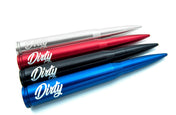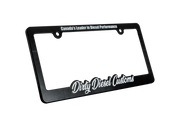In 2007, halfway through the year, Ford Motor Company introduced its latest Super Duty F-Series trucks. The F-250 through F-550 came out the gate boasting a stout 6.4L Powerstroke engine built by International. When the 6.4L Super Duty was first introduced, it was nothing short of a game-changer for Ford owners. For the first time, since the old IDI engine, the fuel system was built on a common rail design rather than the HEUI design (Hydraulic Electronic Unit Injector). Ford was finally in-line with their competition! This meant no more tough starting, rough running, high-pressure oil leaking fun that Ford guys had gotten accustomed to over the last 14 years! Finally, Ford fans didn't have to drive something that was the butt of every diesel joke out there.

Unfortunately, the 6.4L was introduced into the market at the same time as emissions laws became much more strict and manufacturers had to start engineering their trucks to a much higher standard. With the introduction of the first round of the DPF and the increasingly intense EGR systems, these trucks started to plug up quick. This was the early stages of the DPF system, this was before DEF fluid was used and the trucks had to rely on the heat of the engine to burn out the catalysts. They sucked back fuel, but, they made decent power, however, when the emissions systems were removed, the trucks turned in complete animals. At the time, diesel motorsports were becoming quite popular and the 6.4L Super Duty was here to party. With a fuel system and transmission that could handle all the added power, all you need is an exhaust and a tuner and trucks were putting down 500+ horsepower to the wheels and they were getting 20mpg while doing it. The beauty of the 6.4L Powerstroke was how little work you needed to do to turn a boring stock truck into a track monster.
Common 6.4L Problems
It wasn't long until we started to see the odd engine failure here and there, however, we just chalked it up to all the added power we were throwing at them. As time went on, we started to see these trucks more and more for engine work and started to learn a few things. We started to notice a pattern with the condition of the truck and the issues they were having.
With the DPF & EGR systems still intact, the engine was pouring fuel through the cylinders to make enough heat to burn the DPF clean, we found this excess fuel was beginning to dilute the truck's oil with diesel fuel. The first signs of this oil dilution were in the valve train where the rocker tips would start to wear down so quickly, they would begin to stick and sometimes break. The rocker has a small foot on the tip which contacts your valve bridge, this 'foot' allows the rocker to push down two valves simultaneously. These small feet on the tip of the rocker need engine oil to keep everything moving and sliding correctly. As the diesel fuel begins to dilute the oil, these feet lose their lubrication and start getting chewed apart to the point where the rocker itself will start scraping the bridge.

Have you ever heard a 6.4L Super Duty tick? Well, now you know what's likely the culprit. Sometimes, the valves would hang open because the rocker would get jammed on it, really, it's not that difficult of a fix, however, Ford will always take the opportunity to charge you top dollar for these replacement rocker arms and at this time, but there are aftermarket options now available. Here's where it gets interesting, the trucks that had the DPF removed in its early stages of life, we typically see that the rockers look almost brand new, even as the trucks get to the 200,000km range. This is because the truck wasn't constantly having fuel dumped into the oil causing a lack of lubricity in the engine.
Want to guess the next cause of your 6.4L problems? Surprise, it's the EGR System (shocking I know). With the OEM EGR system intact on your 6.4L, we see the front timing cover eroded from coolant cavitation or flash boiling. When we remove the water pump in a 6.4L, it's easy to tell how long the truck had the EGR system installed.
The aluminum front cover is a machined surface for the water pump to sit in and pump coolant around the engine. This is where the EGR coolant comes back into the system after cooling the exhaust gas. This can cause erosion so bad that if you let it go long enough, it will work a hole right through your front cover start leaking coolant down into your oil. Same story as the rocker tips, if the EGR system is removed early in the trucks life, the cover will look brand new, regardless of the mileage of the vehicle.
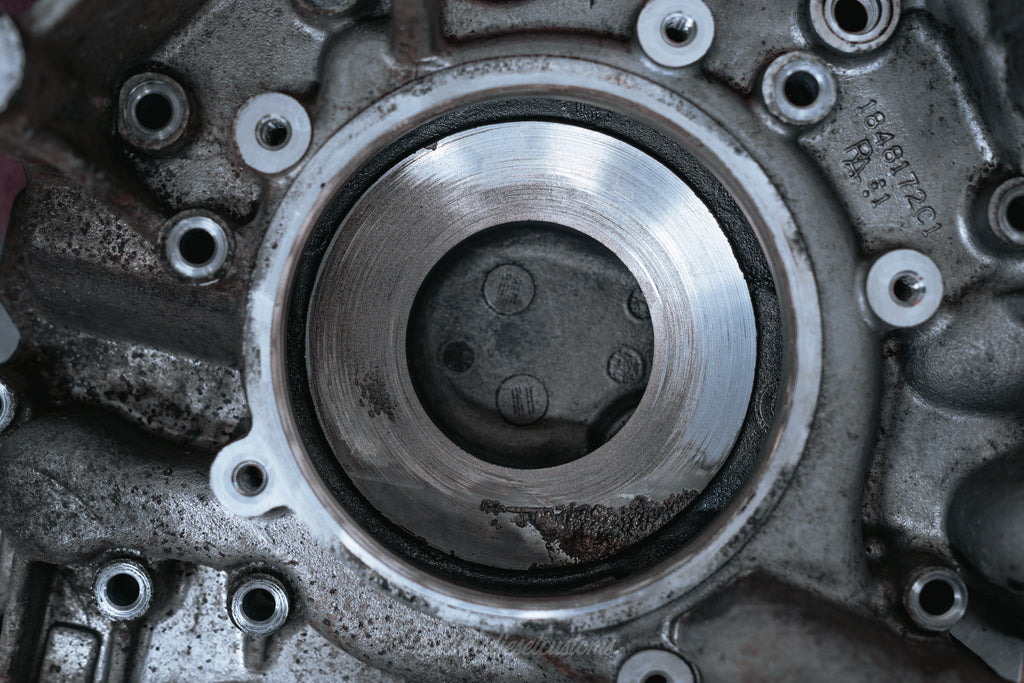
Coolant Cavitation 6.4L Powerstroke
We would see these trucks for headgasket jobs quite often, mainly, everyone in the industry attributed the headgasket failures to the aftermarket tuning. The cylinder head is essentially the same as the 6.0L head from earlier years, however, the 6.4L utilizes a shorter and larger diameter head bolts. This change was a drastic improvement in keeping the gaskets intact. Adding a set of ARP head studs, and a fresh pair of gaskets, your coolant pressure issues were easily solved. Similarly, for the most part, the newer EGR system in these trucks seemed to have solved the oil cooler issues that plagued the 6.0L. we still see a number of these trucks for oil cooler repairs, but nothing like we did in the previous generation, even though the oil cooler is almost identical internally.

Now that these trucks have been running around for 10+ years, the mileage is getting up there and we are seeing these things weekly, if not daily for more serious issues. The most notable being the big bang they like to make, this comes down to a hole in your piston.
A very common call at our shop is "I was driving down the road at a normal speed and out of nowhere my 6.4L has a miss and is puking white smoke out of the tailpipe". This never fails to make my face drop because you know the next thing you have to tell your customer is not only going to ruin their day, it's going to ruin their week.
There doesn't seem to be much rhyme or reason to it, but we rarely see a 6.4L make it over 300,000kms. High HP tuning seems to accelerate it a tiny bit, but, we see it with deleted trucks, and we see it with bone stock trucks. Every time we pull one apart, one of the 8 pistons has a crack from one side to the other. One common method to diagnose this that you've probably seen on YouTube is to take the oil cap off while the truck is running, if it's puffing out of the cap then SHE GONE! Keep in mind, that this can easily be confused with NORMAL CRANKCASE PRESSURE. We hear tons of people freaking out because there is steam coming from their oil cap while the engine is hot.
We have rebuilt countless 6.4L engines now, and from what we can tell, the piston design, in my opinion, is what is killing these things. The 6.4L pistons have a large bowl in the center, this is where the injector fires. The bowl is undercut and has a sharp lip on the top of the piston. There isn't much material here, and this seems to be where the first crack will start. The crack then grows and goes right across the piston in-line with the wrist pin and causes a drop in compression in that cylinder. This is the first sign of a failing 6.4L Powerstroke. As the crack grows, the injector continues to fire fuel into the cylinder, but, there is no heat in the cylinder because it cannot make a good enough seal and create the compression it requires. It may burn some of the fuel, but some of that fuel is simply dumping into the engine oil. When the piston goes up, and the injector fires, this is where that 'puff' of crankcase pressure comes from when you pull off the oil cap on a running 6.4L. As the engine oil dilutes even further, and with the crazy increase of crankcase pressure, sometimes they will start pushing so much vapor into the intake that the engine can run away and start running on its own oil!

Customers Melted Piston from Driving too long with damage.
This WILL happen eventually if you keep driving a 6.4L with a cracked piston, and if it does, normally, you can say goodbye to your injectors because it will quickly melt the tips right off. The best thing to do if a piston is cracked is to get your truck towed to a reliable experienced shop and get it looked after.
Building a 6.4L
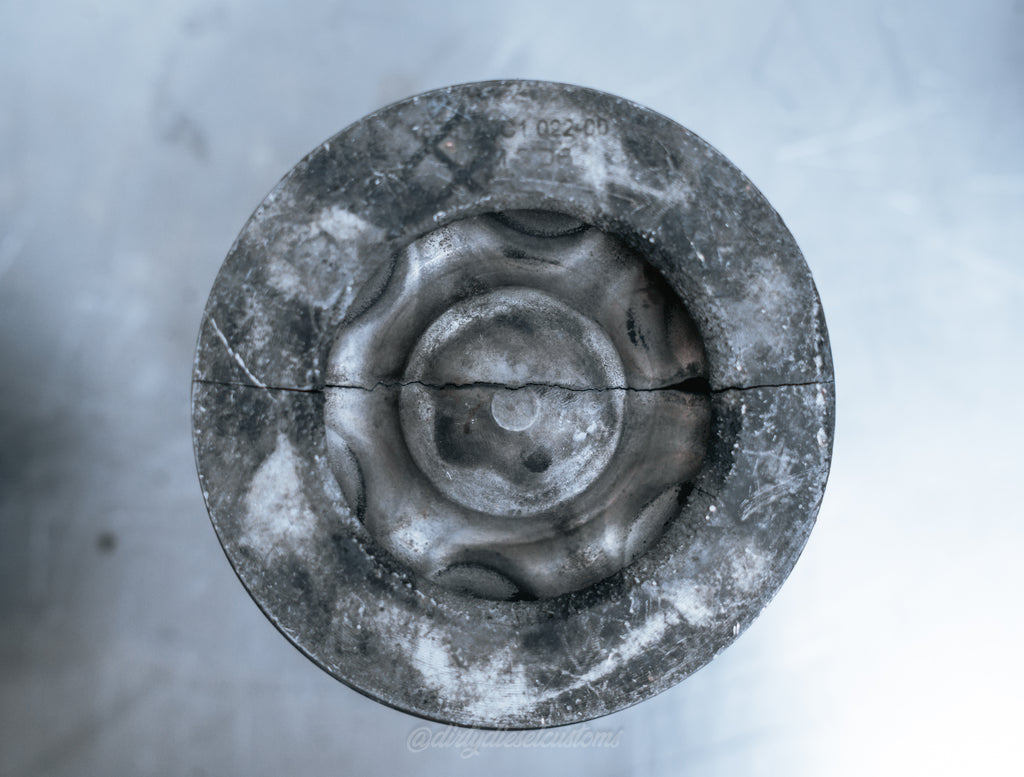
Typical 6.4L Piston from a Customers Engine.
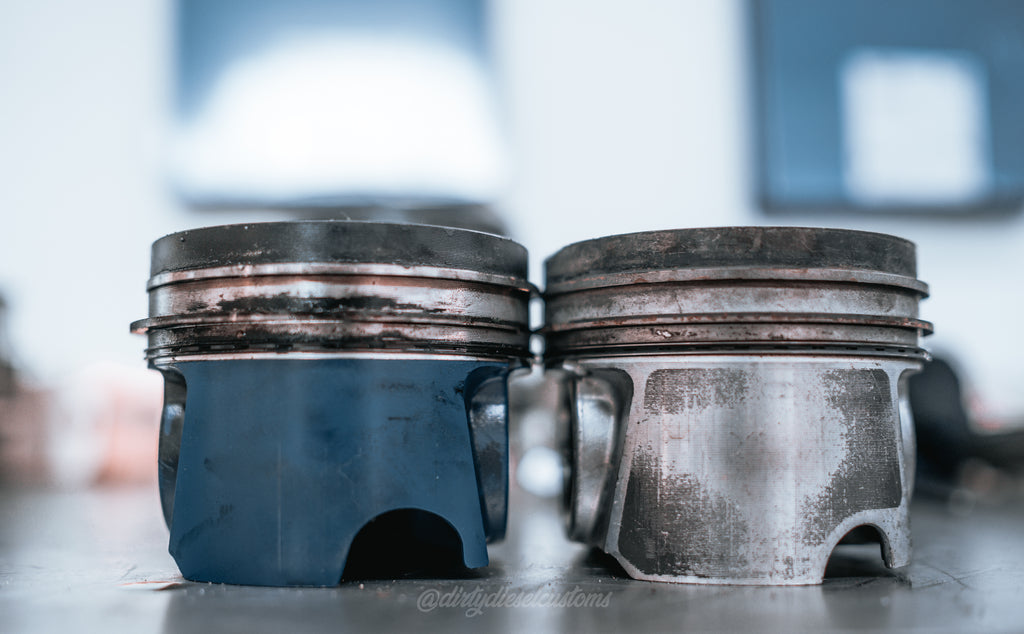
Coated Piston vs Uncoated
We can go on and on about all the extra accessories that you can add to the trucks, but this is just focusing on the internal engine and the issues we’ve found over the years of rebuilding them. I will also proudly say that the 6.4L is still one of my favorite trucks, and after they've been built correctly, they are a blast to drive! The power they put out still runs neck and neck with the new trucks coming out 10 years after they were released. If you need some more information on your 6.4L, or you're thinking it's time for a rebuild, shoot us a message and we can help you determine the right build and setup for your application!




